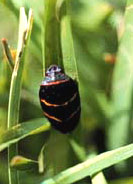Some people call them cuckoo spits. Others call them froghoppers or devil spits. No matter what you call spittlebugs they make a devil of a mess in landscapes. With the end of the drought, University of Georgia experts say spittlebugs are making a comeback around the state.
“During our drought years, two-lined spittlebugs were not as much of a problem because they need a high-moisture environment for the nymphs to develop in turf,” said Kris Braman, an entomologist with the UGA College of Agricultural and Environmental Sciences in Griffin, Ga. “We have had better moisture for two years now, so we might expect spittlebugs to make a comeback.”
Gooey mess
Atlanta radio garden show host Walter Reeves says callers began reporting spittlebug sightings in the spring. “Back in May, people were calling about seeing spittlebugs in Leland Cypress trees in big gooey masses,” he said.
The “goo” Reeves’ callers are seeing is spittle the nymphs make to protect themselves from predators and to maintain their preferred moist environment. It’s not the spittle that should cause concern, it’s the adult bugs that will follow that cause the damage.
"The adults have needle-like mouthparts to extract fluids from the plants," said Braman. "They inject a toxin that causes the grass to wither and turn brown. You will notice purplish streaking, browning and dieback on grasses that are repeatedly heavily infested.”
Nymphs are easy to spot. The spittle gives them away. The adults have distinctive markings. They are a quarter-inch long and have black, wedge- or tent-shaped bodies with two red lines across their backs.
“Because their backs are bright scarlet and exposed when the wings are spread, the effect is almost like a laser pointer zooming across the lawn,” said Will Hudson, a CAES entomologist in Tifton, Ga., who reports spittlebug populations are popping up in southwest Georgia, too.
Grass lovers
Spittlebugs prefer centipede, but feed on other warm-season grasses such as bermuda, zoysia and St. Augustine, too. In the Southeast, they also feed on some woody ornamentals, especially holly trees such as ‘Savannah’ Holly, Braman said.
“If hollies have been infested, the new growth will be twisted and deformed and the leaves will have irregular brown blotches,” she said.
But, if the nymph spittle is appearing in trees, don’t blame the two-line spittlebug.
“Spittlebugs appearing in Leland cypress in north Georgia are a different species, not the two-lined spittlebug that infests turfgrasses and attack hollies,” she said. “The nymphs of the two-lined spittlebug species only feed on nonwoody plants like turfgrass. If you see spittle masses in trees, they weren't put there by two-lined spittle-bugs."
Control measures
Braman says the best way to control spittlebugs is to disrupt their environment.
“Dethatching and topdressing can disrupt the high-moisture environment the nymphs need to survive,” she said. “You can treat with labeled pyrethroid insecticides.”
Be vigilant, though. The season isn’t over.
“The first of two generations have become adults now, so they are very visible,” Braman said. “However, usually the second generation is bigger than the first. It is starting to get dry where I am unless you happen to be underneath one of those pop up thunderstorms. We could have another big adult emergence from late July through August if there is sufficient moisture to support their development.”








